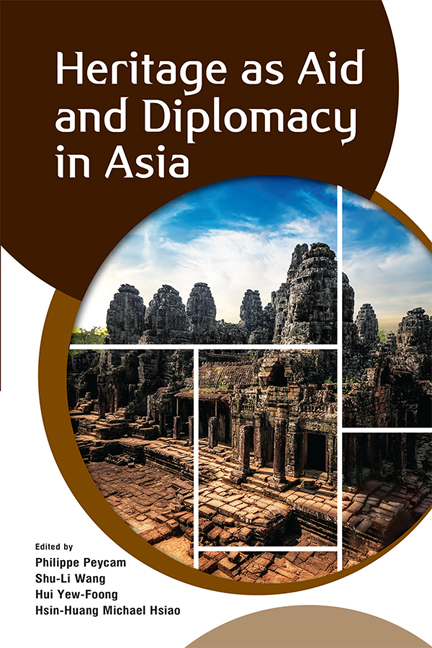Book contents
- Frontmatter
- Contents
- Contributors
- 1 Heritage as Aid and Diplomacy in Asia: An Introduction
- 2 World Heritage and WikiLeaks: Territory, Trade and Temples on the Thai-Cambodian Border
- 3 Heritage Making – Aid For Whom? The Genealogy of Expert Reports in the Hands of Politics and Their Impact in the Case of Preah Vihear
- 4 The International Coordinating Committee for Angkor: A World Heritage Site as an Arena of Competition, Connivance and State(s) Legitimation
- 5 Legacies of Cultural Philanthropy in Asia
- 6 To Help or Make Chaos? An Ethnography of Dutch Expertise in Postcolonial Indonesia
- 7 Heritage Conservation as a Tool for Cultural Diplomacy: Implications for the Sino-Japanese Relationship
- 8 From Ideological Alliance to Identity Clash: The Historical Origin of the Sino-Korean Goguryeo Controversies
- 9 Nationalism, Politics and the Practice of Archaeology in Afghanistan: A Case Study of Bamiyan
- 10 Disappearing Voices: The Politics and Practice of Safeguarding Kunqu Opera in the People’s Republic of China
- 11 Neoliberalizing Heritage: International Agencies and the Local Dynamics of Heritage Conservation in Bali, Indonesia
- 12 Heritage Conservation as Trickle-Down Development
- Index
10 - Disappearing Voices: The Politics and Practice of Safeguarding Kunqu Opera in the People’s Republic of China
Published online by Cambridge University Press: 10 November 2020
- Frontmatter
- Contents
- Contributors
- 1 Heritage as Aid and Diplomacy in Asia: An Introduction
- 2 World Heritage and WikiLeaks: Territory, Trade and Temples on the Thai-Cambodian Border
- 3 Heritage Making – Aid For Whom? The Genealogy of Expert Reports in the Hands of Politics and Their Impact in the Case of Preah Vihear
- 4 The International Coordinating Committee for Angkor: A World Heritage Site as an Arena of Competition, Connivance and State(s) Legitimation
- 5 Legacies of Cultural Philanthropy in Asia
- 6 To Help or Make Chaos? An Ethnography of Dutch Expertise in Postcolonial Indonesia
- 7 Heritage Conservation as a Tool for Cultural Diplomacy: Implications for the Sino-Japanese Relationship
- 8 From Ideological Alliance to Identity Clash: The Historical Origin of the Sino-Korean Goguryeo Controversies
- 9 Nationalism, Politics and the Practice of Archaeology in Afghanistan: A Case Study of Bamiyan
- 10 Disappearing Voices: The Politics and Practice of Safeguarding Kunqu Opera in the People’s Republic of China
- 11 Neoliberalizing Heritage: International Agencies and the Local Dynamics of Heritage Conservation in Bali, Indonesia
- 12 Heritage Conservation as Trickle-Down Development
- Index
Summary
“Invaluable, Rare, Traditional Aesthetics: A Restoration of the Ming Dynasty Mode of Performance.” This was the caption used to market a kunqu opera performance in Beijing's Imperial Granary production of Ming dynasty playwright Tang Xianzu's (1550–1616) play Peony Pavilion. Such words exude authenticity and seek to attract those curious to experience a rare performance of an antiquarian art form. The exoticism and novelty of experiencing an “ancient” and “authentic” performance appeals to the modern (Ivy 1995, pp. 241–42). It prompts the modern to consider that kunqu performances and aesthetics have been irrevocably lost, and thus this performance of Peony Pavilion at the Imperial Granary was to be a rare opportunity not to be missed. Captions like these resonate within the individual—that, because of the rapidly evolving sense of time and changes in political history, environmental context and contemporary culture, much has been lost, and this alarming sense of distance2 appeals to the identity and nostalgia of the Chinese modern, who begins to question their roots and traditions
Performances like these are also marketed towards the international visitor. Printed in English, the production advertises its performance as the “Ultimate Landscape of Chinese Culture: A Must-see for Tourists in Beijing”, with the accompanying words: “Kunqu Opera: A Masterpiece of the Oral and Intangible Heritage of Humanity of UNESCO”. The endorsement by UNESCO places kunqu on the world stage: a source of pride for the nation. The lead performers are young, good-looking and professionally trained from state-sponsored, government-endorsed kunqu opera troupes. The performance has an air of exclusivity. The theatre is small, with intimate seating for an audience of about forty. The setting gives the appearance and allure of the historical home of a member of the literati holding a performance by a private family troupe (jiaban). The performance, without microphones, compels audience members to lean in and be entranced. Ticket prices are hefty, ranging from 380 to 1,980 renminbi. The promises of an authentic, professional, spectacular and exclusive performance are all made.
- Type
- Chapter
- Information
- Heritage as Aid and Diplomacy in Asia , pp. 254 - 277Publisher: ISEAS–Yusof Ishak InstitutePrint publication year: 2020

